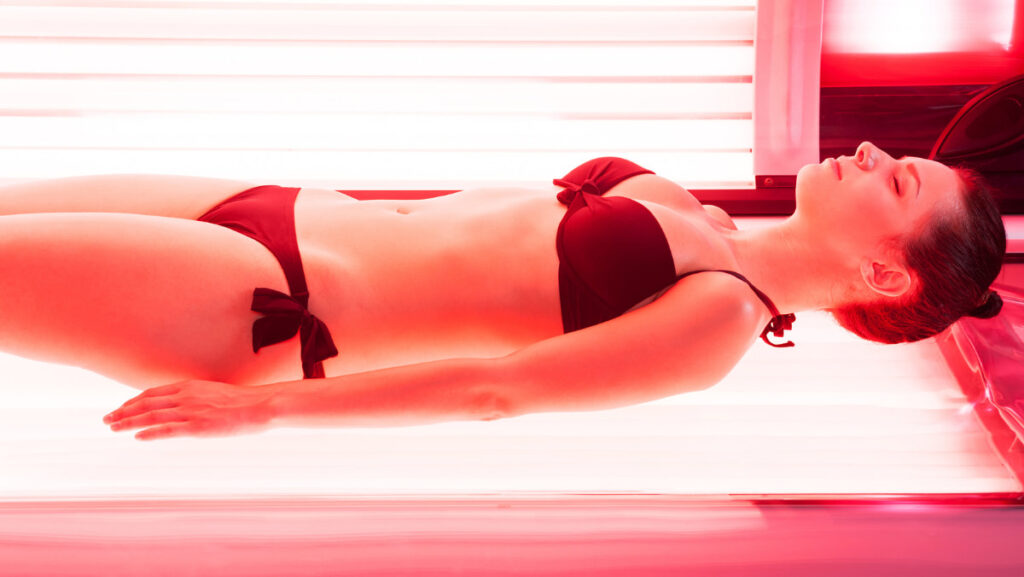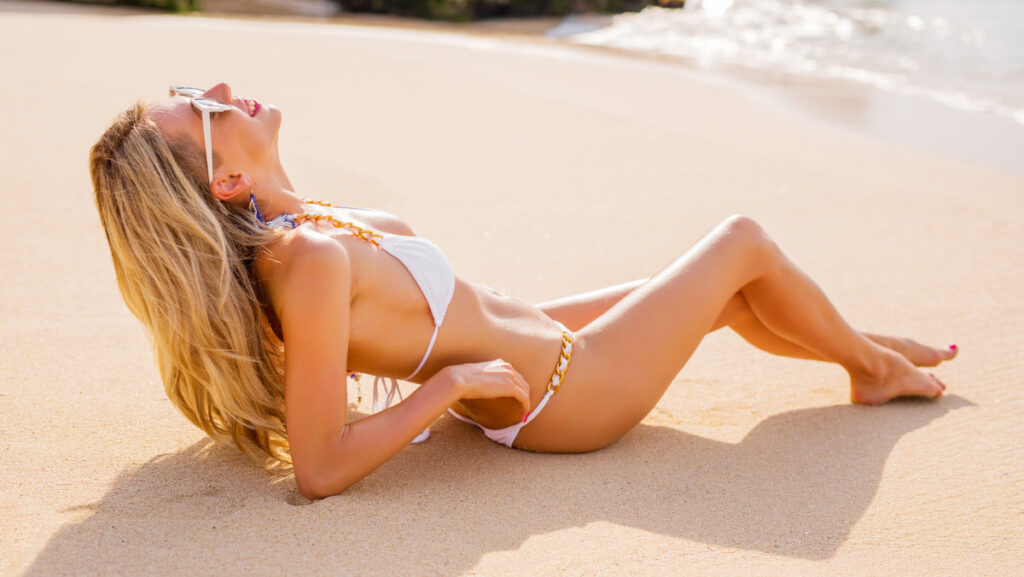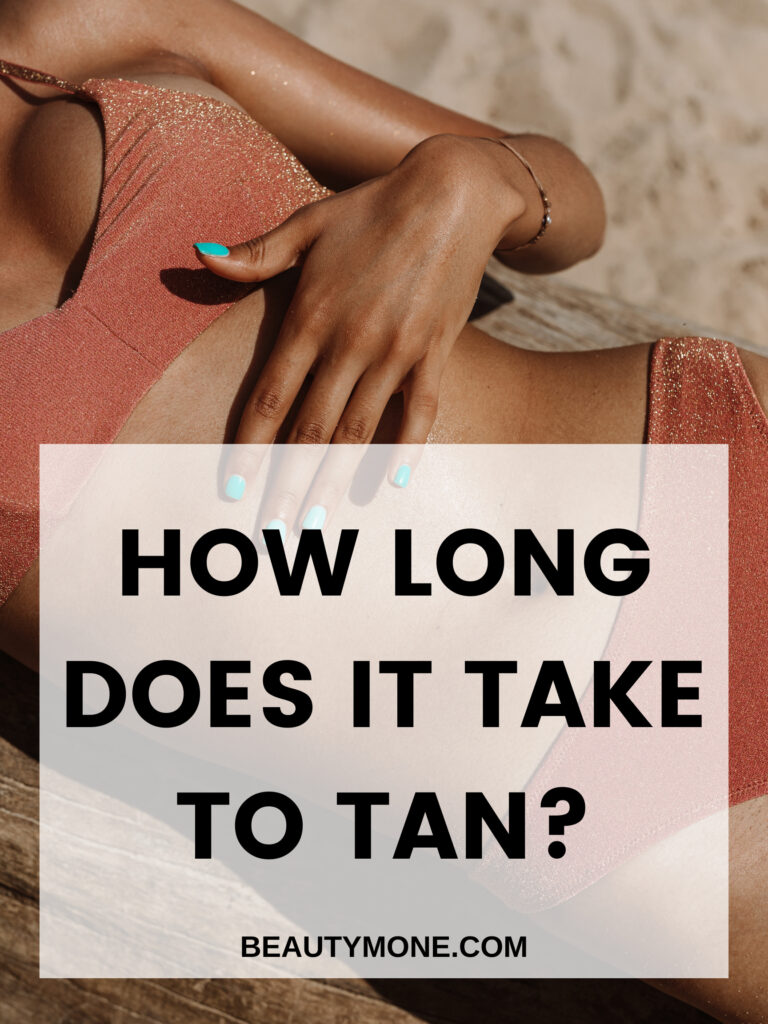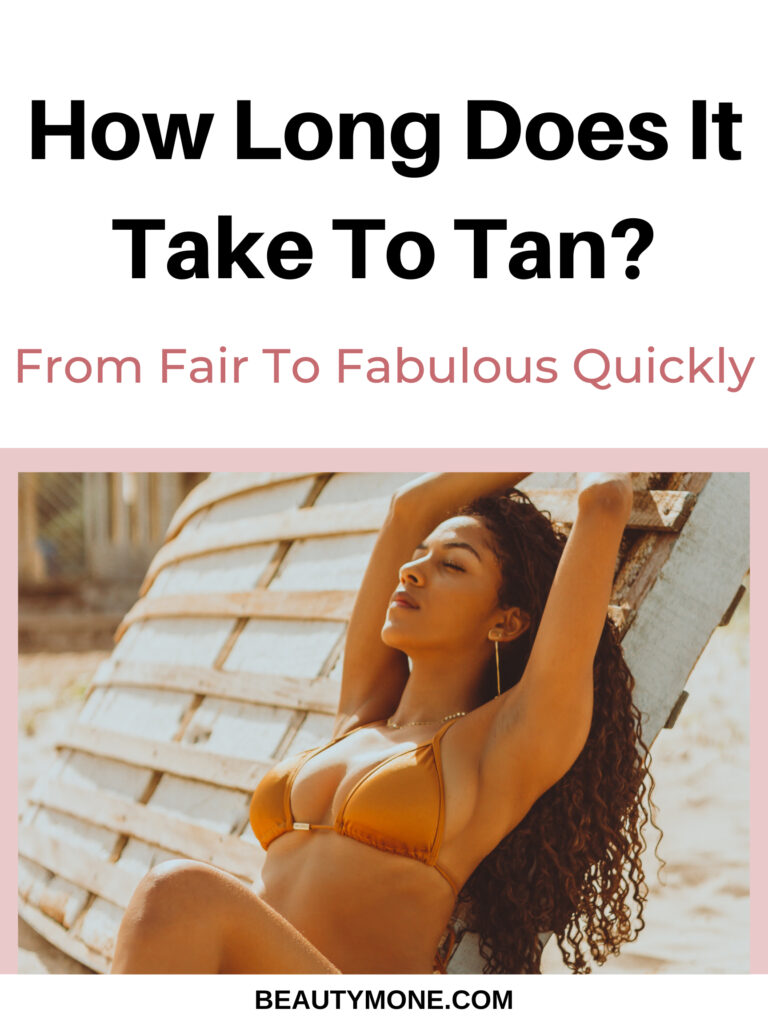
Are you wondering how long does it take to tan? Well, you’re in the right place! The truth is, there’s no one-size-fits-all answer. So many factors come into play when determining how quickly your skin will tan.
Let’s break this down a bit. Your natural skin tone, whether or not you have a base tan, and even your geographical location can all impact the tanning process.
For instance, if you’ve got fair skin that burns easily, it may take longer for you to achieve that sun-kissed glow compared to someone with an olive complexion.
In this article, we’ll explore these factors more deeply and provide some handy tips on how to get the golden hue you desire safely! You don’t want to miss out on these valuable insights. Let’s dive in!
What Happens To The Skin When We Tan?
Ever wondered what’s going on under the surface when your skin starts to tan? Well, it’s all about melanin. Melanin is a pigment produced by cells called melanocytes in your skin.
When you expose yourself to sunlight, especially the ultraviolet B rays (UVB), it sends a signal to these little guys, and they kick into overdrive, producing more melanin.
Ultraviolet (UV) radiation is a form of light invisible to the human eye. UV is classified into three categories: UVA, UVB, and UVC. Although all three types can cause skin damage, it is the UVA rays and UVB rays that have the greatest impact on humans.
This process is essentially your body’s natural defense mechanism against harmful UV radiation. It’s like Mother Nature’s sunscreen, designed to protect you from sunburns and potential damage that could lead to skin cancer.
Now let’s delve a bit deeper into how this works:
- Step 1: You soak up some sun! UVB rays penetrate the upper layer of your skin (the epidermis).
- Step 2: Your body senses this invasion and sends out an SOS for help.
- Step 3: Cue the melanocytes! These cells start producing more melanin in response.
- Step 4: The extra melanin absorbs UV light, which helps shield your DNA from damage.
However, there are different types of tanning – Immediate Pigment Darkening (IPD) and Delayed Tanning (DT).
IPD occurs during exposure or shortly after due to photooxidation of existing melanin. This tan fades quickly within hours or days once you’re out of the sun.
On the other hand, DT happens gradually over days as new melanins are synthesized and distributed between keratinocytes – these are another type of cell found in our outermost layer of skin. Unlike IPD, DT is long-lasting but requires continued exposure for maintenance.

Which Factors Influence How Fast You Get A Tan?
Ever wondered why some folks turn a gorgeous golden brown after just a few hours in the sun while others spend all day baking and barely get past pasty?
It’s not just about how much time you’re spending outside. There are several factors that play into how quickly your skin tans. Let’s dive in!
Your Genetics & Skin Type
Let’s start with something you can’t change: your genetics. The type of melanin your body produces is genetically determined and greatly influences how fast you tan.
- Eumelanin: If your body produces more eumelanin, you’ll typically tan faster and darker.
- Pheomelanin: Those who produce more pheomelanin usually burn before they tan or don’t tan at all.
Skin type plays a significant role in determining how quickly one can tan. The Fitzpatrick Skin Type Scale categorizes skin types with numbers I to VI based on their response to sun exposure.
Darker skin has more natural protection against UV rays, which means it can often withstand longer periods of exposure without burning. Here’s an overview of how it looks per skin type:
| Skin Type | Description | Tanning Tendency |
|---|---|---|
| I | Very fair | Burn easily, tan very minimally |
| II | Fair | Moderate burn, develop a minimal tan |
| III | Medium | Sometimes mild burn, tans uniformly |
| IV | Olive | Rarely burn, always tans well |
| V | Brown | Rarely burn, tans very easily |
| VI | Very dark | Sometimes mild burn tans uniformly |
The Duration Of Sun Exposure
It might seem like a no-brainer, but the amount of time spent under the sun directly affects how fast you’ll see results from tanning. However, there’s a catch!
Your skin hits a tanning cut-off point (usually 2-3 hours) where it won’t produce any more melanin for the day – so longer isn’t always better!
The Intensity Of UV Radiation
UV radiation intensity is another key factor affecting your rate of tanning. This can vary based on the following:
- Time of Day: UV rays are strongest between 10 AM and 4 PM.
- Season: Summer months have stronger UV radiation than winter ones.
- Weather Conditions: Clouds don’t block as much UV as you’d think – up to 80% still gets through!
Remember, though, high intensity doesn’t mean healthy! Too much UV exposure increases the risk of skin damage and cancer, so always protect yourself.
Your Location & Altitude
Finally, where you’re catching your rays can make a difference, too. UV exposure increases with altitude – for every 1000 meters above sea level, UV levels increase by about 10%. Plus, the closer to the equator you are, the stronger the sun’s rays will be.
So if you’re tanning on a mountain in Ecuador…well, let’s just say you’ll bronze up quicker than if you were at a beach in Maine!
It’s crucial to remember that excessive tanning and sun exposure can increase the risk of skin cancer and other skin-related issues, like premature aging. It’s always best to be cautious and protect your skin while enjoying the outdoors.
How Long Does It Take To Tan In The Sun?
You may burn or tan in as little as 10 minutes if you’re not wearing sunscreen with SPF. Most people will tan within a few hours.
Sometimes, you will not see a tan right away. In response to sun exposure, the skin produces melanin, which can take time. This eventually changes the color of the skin.
How long it takes you to tan outside will depend on your skin type and the climate in which you’re tanning.
For example, consider two people sitting on a beach: one with light skin and one with darker skin. The light-skinned person may burn, while the darker complexions tan (which still damages the skin).
Here’s an indication per skin type of how quickly you can develop a tan (mind you, you CAN, but it’s no guarantee as everyone’s skin is different):
| Skin Type | Description | Sun Exposure Time for Tanning |
|---|---|---|
| I | Pale-white skin, usually freckled and burns easily | 10-30 minutes |
| II | Fair skin, burns before tanning | 10-30 minutes |
| III | Medium, tans gradually | 20-30 minutes |
| IV | Olive or light brown tans easily | 40-60 minutes |
| V | Darker skin tones/Moderately pigmented brown skin, very rarely burns | 40-60 minutes |
| VI | Dark skin tones (dark brown skin and black skin) never burns | 40-60 minutes |
To minimize the risk of burning, it’s useful to remember these tips on how to tan without burning:
- Apply a broad-spectrum sunscreen with an appropriate SPF for your skin type;
- Limit sun exposure during peak UV hours (10 a.m. to 2 p.m.);
- Gradually increase sun exposure time to build a base tan;
- Wear protective clothing and take breaks in the shade.
What UV Index Is Best For Tanning From UV Rays?
We’ve all heard about UV rays and their effects on our skin. But what exactly is the best UV index for tanning? Typically, a UV index of 3 or higher is ideal for tanning.
However, remember this doesn’t mean you can skip out on your sunscreen! The stronger the rays are the more protection your skin needs.

Can You Still Tan Using SPF?
Lots of people are wondering if you can tan with sunscreen. It’s a common myth that using sunscreen will prevent you from getting a tan – but that couldn’t be further from the truth!
Even with SPF on board, your skin can still produce melanin (the pigment responsible for tans). So yes – slather up with SPF to protect yourself from harmful rays while still working on that golden glow.
Tips To Speed Up The Tanning Time (Without Sunburn)
When it comes to tanning naturally, sun exposure duration plays a critical role. By understanding how to tan without burning and incorporating techniques on how to tan faster, you’ll be well on your way to the desired tanned complexion.
Here are some helpful tips that will prepare you for a faster tanning session and are good to keep in mind during your tanning session outside:
- Exfoliate: Exfoliating your skin before sunbathing can help remove dead skin cells, ensuring a more even tan.
- Hydrate: Drinking plenty of water and using a moisturizer prevents dry skin, allowing for a more even and long-lasting tan.
- Sunscreen: Applying sunscreen with SPF 15-30 helps protect against harmful UV rays while still allowing for tanning. Reapply every 2 hours or after swimming.
- After-sun lotion: Besides drinking water, moisturizing your body from the outside after a tanning session to replenish its moisture is a great idea to help with the tanning process. Look for products that contain aloe vera, hyaluronic acid, or glycerin.
Now, for those looking for ways to tan fast, here are some suggestions:
- Use a tanning accelerator: Tanning accelerators contain ingredients such as tyrosine or melanin, which can help your skin produce more melanin, resulting in a faster tan.
- Opt for water activities: Water can amplify UV radiation, making your tan develop more quickly.
- Sunbathe during peak UV hours: This is typically between 10 AM and 3 PM; however, be cautious and take necessary breaks to prevent overexposure.
- Rotate your body frequently so every area receives equal sun exposure.
- Eat lycopene-rich foods like tomatoes, tomato paste, and watermelon, which can help naturally fight UV rays (but should not replace SPF!)
- Eat foods that contain beta-carotene, like carrots, that can naturally darken the skin.
- Place a reflective sheet or towel underneath you to reflect sunlight better onto your skin.
- Combine outdoor sun tanning with indoor tanning sessions.
Tan Accelerators: Do They Work?
Tan accelerators claim to speed up your body’s natural tanning process. While they do contain ingredients like tyrosine, which stimulates melanin production – there isn’t enough scientific evidence yet to fully support these claims.
As always, if you decide to give them a try, make sure they have good reviews and use them responsibly alongside regular sun protection.
Is It Possible To Tan Without Sun Exposure?
Thinking about my mom, I know she doesn’t like being in the sun (even though you can still tan in the shade!) – it’s just too hot, and she gets sweaty.
Nah, she’s not really done for that experience. If you’re like my mom, I have good news for you! Thankfully, there are several ways to tan without sun exposure.
Tanning Beds
When it comes to indoor tanning, the process can be efficient and safe if done correctly. In this section, I’ll be discussing how long it takes to tan using tanning beds and various ways you can optimize your tanning experience without burning your skin.
For those who wonder how long does it take to get a tan, tanning beds can typically take anywhere between 6-10 sessions or 2-4 weeks to maintain a noticeable and lasting tan. Just like tanning outside, the time it takes to see results depends on the following:
- Your skin type
- The type of tanning bed used
- The tanning salon’s guidelines
Given the significance of skin type, I’ve compiled a table with the average tanning time for each skin type:
| Skin Type | Tanning Tendencies | Time To Tan (Indoors) |
|---|---|---|
| Type I | Always burns, never tans | Not suitable for tanning beds |
| Type II | Usually burns, tans minimally | 20-30 minutes |
| Type III | Sometimes burns, tans moderately | 15-20 minutes |
| Type IV | Rarely burns, tans well | 12-15 minutes |
| Type V | Very rarely burns; tans easily | 10-12 minutes |
| Type VI | Almost never burns, tans darkly | 8-10 minutes |

It’s crucial to note that exceeding the recommended time for your skin type increases the risk of burns and skin damage. To ensure a fast and even tan, follow these recommendations:
- Exfoliate before tanning to remove dead skin cells and allow the UV rays to penetrate your skin.
- Always use SPF 30+, even when tanning indoors/in a tanning bed, to protect yourself.
- Rotate your body during the session to ensure an evenly distributed tan
- Space your tanning sessions at least two days apart, allowing your skin to rest and develop more melanin for a darker tan.
While tanning beds can be a quicker option for those seeking that golden glow, it’s essential to understand the risks indoor tanning poses. UV radiation from tanning beds may contribute to skin aging, sunburn, and an increased risk of skin cancer.
Self-Tanning Products
We all know that high levels of direct sunlight on our skin are dangerous and can eventually even lead to skin cancer. So now more than ever, we’re looking for other solutions to still get that bronzed glow.
The safest ways to get a tan without any skin damage or potential sunburns are self tanning products. Especially if you have a lighter skin tone that has difficulty to tan, self-tanners are true heroes!
Self-tanners have an active ingredient called dihydroxyacetone (DHA), which reacts with amino acids in the top layer of your skin to produce a natural-looking tan.
Available self-tanning products:
- Self Tanning Lotions
- Self tanning Mousses
- Self Tanning Sprays & Mists
- Self Tanning Wipes
The timing of self-tanners depends on the product you’re using, but generally, your tan will start to appear within 2-4 hours of application.
The intensity of your tan will peak at around 24 hours—and it should last for about a week (if you take proper care of your skin).
| DHA concentration | Development Time |
|---|---|
| 2-4% | 2-4 hours |
| 4-6% | 4-6 hours |
| 6-10% | 6-8 hours or longer |
To make the most of your self-tanning experience, I recommend following these steps to achieve a quicker, more even tan:
- Exfoliate your skin before application to remove dead skin cells.
- Moisturize areas that tend to absorb more product, like knees, elbows, and ankles.
- Use a tanning mitt for even distribution and avoid stained hands.
- Apply in circular motions, starting from your feet and moving upwards.
- Wait at least 10 minutes before getting dressed or touching any fabrics.
Want even more tips about self tanning? No worries, I’ve got you covered in this thorough step-by-step beginner-friendly guide on how to self tan.
Bali Body Self Tanning Mousse and Coco & Eve Sunny Honey Bronzing Face Drops are excellent examples of products that can help you achieve a quick, natural-looking tan. Here are some of my other favorite self tanning products:
Spray Tans
A spray tan is a sunless tanning method that gives your skin a beautiful, bronzed glow without exposing it to harmful UV rays from the sun or tanning beds.
It’s like a magical potion for your skin that can make you look like you’ve just spent a week on a tropical beach!
Spray tanning involves the application of a specially formulated solution to your skin, which contains an active ingredient called Dihydroxyacetone (DHA).
DHA interacts with the amino acids in the top layer of your skin to create a temporary tan effect. Don’t worry; it’s completely safe and approved by dermatologists.
There are several fantastic reasons to opt for a spray tan:
- Safe Sun Alternative: Spray tans are the perfect solution for those who want a golden tan without the risk of skin damage from UV radiation. Protect your skin and still look sun-kissed!
- Instant Gratification: Unlike natural tanning, which can take days or weeks to develop, a spray tan provides instant results. You’ll walk out of the tanning session looking like you just came back from a beach vacation.
- Customizable Shades: Spray tans come in various shades, so you can choose the level of tan that suits your preference, from a subtle glow to a deep bronze.
- Even Coverage: Professional spray tans are typically administered by trained technicians who ensure even coverage, avoiding streaks or uneven coloration.
- Temporary and Fade Gracefully: Spray tans gradually fade over time, so you won’t be left with awkward tan lines or patchy skin as it wears off.
Expert Q&A

How Long And Often Should I Lay Out To Tan?
Tanning should be done gradually to prevent skin damage. Starting with 15-minute sessions a few times a week can help your skin adapt to sun exposure without getting burnt.
You can then gradually increase this time as your tolerance grows, but never exceed 30 minutes at a time.
Do Tans Go Away Naturally?
Yes, they do! Your body naturally sheds skin cells over time, which causes the tan to fade away, usually within ten days to three weeks, depending on how deep the tan is.
How Do I Keep My Natural Tan For Longer?
Great question! Here are some pointers:
- Stay hydrated: Dry skin tends to shed faster, so drink plenty of water.
- Moisturize daily: This helps keep your skin healthy and prolongs the life of your tan.
- Exfoliate before tanning: It’ll help you get an even color that lasts longer.
Just remember not all skins react similarly due to various factors such as genetics and individual skincare routines!
Does SPF Impact Your Tanning Time?
SPF does impact your tanning time! Higher SPF gives more protection from UVB rays, thus slowing down the process of developing a suntan.
If you’re using sunscreen with high SPF, it might take longer for you to see visible results, but trust us, your skin will thank you in the long run!
How Can I Prevent Skin Cancer While Tanning?
Your health is paramount, and it’s vital to take precautions when you’re out in the sun. Remember, overexposure to UV rays increases the risk of skin cancer. So here are some tips:
- Always wear sunscreen with a high SPF.
- Avoid tanning during peak sunlight hours (10 AM – 4 PM).
- Wear protective clothing like hats and sunglasses.
- Reapply sunscreen every two hours or after swimming.
Warning: UV Rays Can Cause Skin Cancer
So, you’re looking forward to getting that sun-kissed glow, huh? It’s a great feeling for sure, but there’s something we need to talk about first – the risk of skin cancer due to exposure to UV rays.
Yes, it might sound like a buzzkill right now, but trust me on this one – being aware is better than being sorry.
In fact, according to The American Academy of Dermatology Association (AAD), an estimated 1 in 5 Americans will develop skin cancer in their lifetime due to prolonged exposure to these UV rays. That’s quite a staggering number!
Let’s take it up a notch and talk about melanoma – the most dangerous type of skin cancer caused by intense UV exposure.
This isn’t just another statistic; it’s life-threatening! Melanoma is responsible for the majority of deaths related to skin cancer.
Here are some key statistics from AAD:
- It is estimated that approximately 9,500 people in the U.S. are diagnosed with skin cancer every day.
- Research estimates that nonmelanoma skin cancer (NMSC), including basal cell carcinoma (BCC) and squamous cell carcinoma (SCC), affects more than 3 million Americans a year.
- More than 1 million Americans are living with melanoma.
- Before age 50, rates are higher in women compared to men. After age 50, and in general, men have higher rates. White populations have higher rates compared to other races.
- Skin cancer can affect anyone, regardless of skin color.
But don’t let all this scare you away from your tanning goals entirely! There are ways around this while still enjoying your time under the sun safely:
- Limit your direct sunlight exposure during peak hours (10 AM – 4 PM)
- Slather on broad-spectrum sunscreen with at least SPF30
- Wear protective clothing and accessories like hats and sunglasses
- Regularly check for unusual changes on your skin
Remember, achieving that perfect tan doesn’t mean putting your health at stake! Be mindful of these precautions when catching those rays because nothing beats safety and awareness when it comes to enjoying some fun under the sun.
How Long Does It Take To Tan Conclusion
Wrapping up, we’ve talked a lot about tanning, and I bet you’re itching to soak up some rays. But remember, everyone’s skin is unique! So, your personal tanning timeline might vary.
On average, you’ll start seeing a tan after about 1-2 hours of sun exposure. For that deep bronzed look, it could take anywhere from several days to a few weeks of consistent sunbathing. Just don’t forget – moderation is key here!
| Average Time | Result |
|---|---|
| 1-2 Hours | Initial Tan |
| Several Days | Deeper Tan |
| Few Weeks | Bronzed Look |
Tanning isn’t just about looking good, though. It’s also crucial for the production of Vitamin D in your body, which supports healthy bones and boosts immunity.
However, there are risks involved too:
- Premature aging
- Skin burns
- Increased risk of skin cancer
It’s essential to balance your desire for that golden glow with safety precautions like using sunscreen and limiting time spent under direct sunlight.
In case you’re not much into basking under the scorching sun or if it’s cloudy outside (you know those days), artificial methods can come in handy:
- Tanning beds: These mimic natural sunlight but use UV radiation.
- Spray tans: They give instant color without any UV exposure.
Well then, folks, armed with all this knowledge, I believe you’re ready to achieve that beautiful tan safely and smartly! Go ahead and enjoy the sun responsibly!
Frequently Asked Questions
Articles Sources
We want you to know that the information in this article is meant to be informative, but it’s no substitute for chatting with a healthcare pro. If you have any concerns about your health or a specific condition, do yourself a favor and reach out to a qualified medical expert.
We do our best to keep things accurate and up-to-date, but the world of medicine moves fast. To get the latest and most reliable info, consider checking out the sources we’ve used in this article:
- Guy GP, Thomas CC, Thompson T, Watson M, Massetti GM, Richardson LC. Vital signs: Melanoma incidence and mortality trends and projections—United States, 1982–2030. MMWR Morb Mortal Wkly Rep. 2015;64(21):591-596.
- Rogers HW, Weinstock MA, Feldman SR, Coldiron BM. Incidence estimate of nonmelanoma skin cancer (keratinocyte carcinomas) in the US population. JAMA Dermatol. Published online April 30, 2015.
- SEER Cancer Stat Facts: Melanoma of the Skin. National Cancer Institute. Bethesda, MD, http://seer.cancer.gov/statfacts/html/melan.html.
- American Academy of Dermatology/Milliman. Burden of Skin Disease. 2017. www.aad.org/BSD.
- Green AC, Williams GM, Logan V, Strutton GM. Reduced melanoma after regular sunscreen use: randomized trial follow-up J Clin Oncol Jan 20, 2011:257-263; published online on December 6, 2010.
We’ve tapped into these sources to create this content, and they can dive deeper into the topics we’ve covered. Remember, though, always consult with your healthcare provider for personalized medical advice and recommendations.



